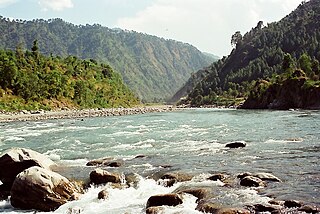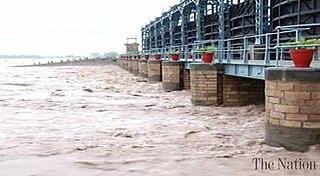
The Indus is a transboundary river of Asia and a trans-Himalayan river of South and Central Asia. The 3,180 km (1,980 mi) river rises in Western Tibet, flows northwest through the Ladakh and Gilgit-Baltistan regions of Kashmir, bends sharply to the left after the Nanga Parbat massif, and flows south-by-southwest through Pakistan, before it empties into the Arabian Sea near the port city of Karachi.

Bahawalpur was a princely state of British India, and later Pakistan, that was a part of Punjab States Agency. It existed as an autonomous state from 1947 to 1955. The state covered an area of 45,911 km2 (17,726 sq mi) and had a population of 1,341,209 in 1941. The capital of the state was the town of Bahawalpur.

The Beas River is a river in north India. The river rises in the Himalayas in central Himachal Pradesh, India, and flows for some 470 kilometres (290 mi) to the Sutlej River in the Indian state of Punjab. Its total length is 470 kilometres (290 mi) and its drainage basin is 20,303 square kilometres (7,839 sq mi) large.

The Ravi River is a transboundary river crossing northwestern India and eastern Pakistan. It is one of six rivers of the Indus System in Punjab region.

The Sutlej or Satluj River is the longest of the five rivers that flow through the historic crossroads region of Punjab in northern India and Pakistan. The Sutlej River is also known as Satadree. It is the easternmost tributary of the Indus River.The Bhakra Dam is built around the river Sutlej to provide irrigation and other facilities to the states of Punjab, Rajasthan and Haryana.

Panjnad River (Urdu/Punjabi Shahmukhi: پنجند, is a river at the extreme end of Bahawalpur district in Punjab, Pakistan. Panjnad River is formed by successive confluence or merger of the five rivers of the Punjab, namely Jhelum, Chenab, Ravi, Beas and Sutlej.

Sukkur Barrage is a barrage on the River Indus near the city of Sukkur in the Sindh province of Pakistan. The barrage was built during the British Raj from 1923 to 1932 and was named Lloyd Barrage. The Sukkur Barrage, is the pride of Pakistan's irrigation system as it is the largest single irrigation network of its kind in the world. It irrigates from Sukkur district in the north, to Mirpurkhas/Tharparkar and Hyderabad districts in the south of Sindh, almost all parts of the province. It is situated about 500 kilometres northeast of Karachi, 5 kilometres below the railway bridge, or the Sukkur Gorge. The introduction of barrage-controlled irrigation system resulted in more timely water supplies for the existing cultivated areas of Sindh province of Pakistan.
The Indus Waters Treaty (IWT) is a water-distribution treaty between India and Pakistan, brokered by the World Bank, to use the water available in the Indus River and its tributaries. It was signed in Karachi on 19 September 1960 by Indian Prime Minister Jawaharlal Nehru and Pakistani President Ayub Khan.

Guddu Barrage is a barrage on the Indus River near Kashmore in the Sindh province of Pakistan. President Iskander Mirza laid the foundation-stone of Guddu Barrage on 2 February 1957. The barrage was completed in 1962 at a cost of 474.8 million rupees and inaugurated by Field Marshal Ayub Khan in 1962.

Head Taunsa Barrage is a barrage on the River Indus in Taunsa Tehsil of Dera Ghazi Khan District, Punjab province of Pakistan. It is situated 20 kilometres southeast of Taunsa Sharif and 16 kilometres from Kot Addu. This barrage controls water flow in the River Indus for irrigation and flood control purposes. Taunsa Barrage was designated a Ramsar site on 22 March 1996.

Khanki Headworks is a headworks situated on the River Chenab in Gujranwala District of the Punjab province of Pakistan. The construction of this headworks was completed in 1889 and was one of the oldest headworks in Pakistan.

Marala Headworks is a headworks situated on the Chenab River near the city of Sialkot in Punjab, Pakistan. A weir was first built during 1906–1912 in British India to feed the Upper Chenab Canal, as part of the 'Triple Canals Project'. A new Marala Barrage was constructed in 1968 to feed the Marala–Ravi Link Canal in addition to the original Upper Chenab Canal.

Mailsi , (Punjabi:میلسی) is a city located Punjab, Pakistan. The city of Mailsi is also the headquarters of Mailsi Tehsil, an administrative subdivision of Vehari District.

Taunsa, is a city and capital of Taunsa Tehsil of Dera Ghazi Khan District in the Punjab province of Pakistan.
Rasul Barrage is a barrage on the River Jehlum between Jhelum District and Mandi Bahauddin District of the Punjab province of Pakistan. It is situated 72 km downstream of Mangla Dam.
The Sirhind Canal is a large irrigation canal that carries water from the Sutlej River in Punjab state, India. It is one of the oldest and biggest irrigation works in the Indus river system, and was inaugurated in 1882 CE. The canal begins at Ropar headworks near Ropar city in Rupnagar district of Punjab.

The topography of Pakistan is divided into seven geographic areas: the northern highlands, the Indus River plain, the desert areas, the Pothohar Plateau, Balochistan Plateau, Salt Range, and the Sistan Basin. All the rivers of Pakistan, i.e. Sindh, Ravi River, Chenab River, Jhelum River, and Sutlej River, originate from the Himalayas mountain range. Some geographers designate Plateau as to the west of the imaginary southwest line; and the Indus Plain lies to the east of that line.

Sulemanki Headworks is a headworks on the River Sutlej near Okara, in the Punjab province of Pakistan.

Madhopur Headworks is a barrage on the Ravi River in the Indian state of Punjab. It is located in the Pathankot district on the border with Jammu and Kashmir. The Upper Bari Doab Canal (UBDC) off-taking from Madhopur irrigates agricultural lands in Punjab and provides water to the cities of Gurdaspur, Batala and Amritsar.

Punjab Irrigation Department, Pakistan, is a provincial irrigation department in the Punjab province of Pakistan. Punjab Irrigation Department irrigates 21 million acres (8,500,000 ha) of agricultural land in Punjab. Muhammad Mohsin Leghari, an MPA from Rajanpur, is the Minister for Irrigation. Secretary Irrigation Engineer Aamer Khattak to the government of the Punjab is the administrative head of the department.



















